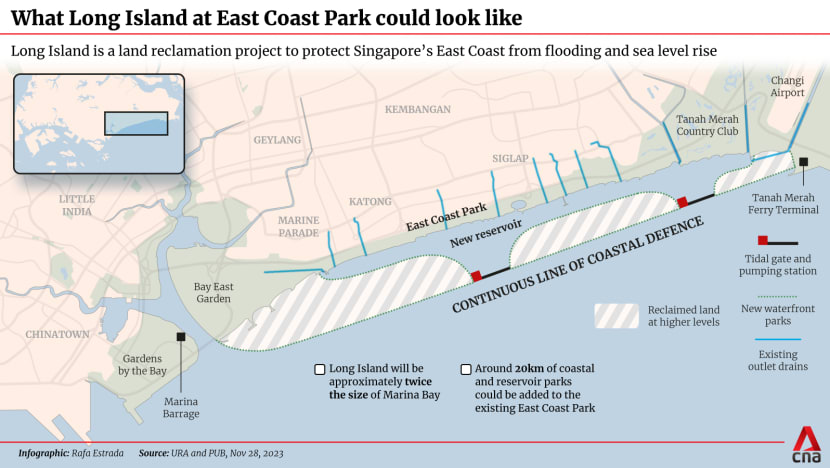SINGAPORE: A mix of private and public properties with the potential for up to 60,000 new homes would likely be built on the upcoming “Long Island” reclaimed site at East Coast Park’s shoreline, property analysts told CNA.
With no firm plans in place, however, it remains to be seen how existing properties along the East Coast will be affected in terms of prices and views, the analysts added.
The government on Tuesday (Nov 28) announced that it will begin technical studies for the decades-long project to see how coastal protection measures can be integrated with the reclamation plans. These studies will be carried out over the next few years starting from 2024.
When completed, Long Island could span 800ha – nearly the size of 1,142 football fields – and potentially provide more opportunities for waterfront living and jobs, said National Development Minister Desmond Lee.
The site would be about twice the land area of Marina Bay and add around 20km of new coastal and reservoir parks, tripling the length of the existing waterfront area along East Coast Park.
The concept of Long Island was first raised by Prime Minister Lee Hsien Loong during the National Day Rally in 2019.
EXISTING SEA VIEWS COULD BE BLOCKED
Analysts said housing on Long Island will probably be a combination of low- and high-rise developments, similar to Sentosa.
“There could be a mix of public and private housing units, as well as more recreational facilities, nature spots and green belts,” said OrangeTee & Tie’s senior vice president of research and analytics Christine Sun. “There may even be some alfresco dining options offering an outdoor dining experience along the seaside.”
Mr Lee Sze Teck, senior director for data analytics at Huttons Asia, said it was “highly likely” that there will be more land allocated for public housing rather than private housing. Housing and Development Board (HDB) flats will be launched under the Prime or Plus model given the prime location along the East Coast, he added.
“The chances of creating a second Sentosa are low as the government wants to create an inclusive society allowing everyone access to good homes and not just for the rich,” he said.
Mr Lee also raised the potential for between 30,000 and 60,000 homes to be built “with a good mix of commercial, recreational and greenery”, given that Long Island is likely to be similar in size to the Kallang/Whampoa district.
With the majority of private developments along East Coast being freehold estates, these homeowners will benefit from future developments on Long Island. This may even increase the potential for en-bloc, Mr Lee added.
However, he warned that the views from some lower-level homes may be blocked by developments on Long Island in the future.
Other analysts said it was too early to tell how many homes could be built, but concurred that some existing homes along the East Coast with unblocked sea views may eventually be affected, depending on the type and location of housing developments on Long Island.
It was announced on Tuesday that Long Island would create an enclosed waterbody in front of East Coast Park, transforming it into a freshwater reservoir.
Ms Sun said that some homes with sea views may ultimately have reservoir views, but some homes could still enjoy “beautiful skyline views” at night if high-rise buildings are built on Long Island.
She further noted that the master plan for Long Island is not expected to be revealed until 2030, with construction set to take place many years after the government has explored the feasibility of the project.
“In the long term, the market impact will depend on the specifics of the development plan. Factors such as the type and height of buildings, as well as the setback from existing coastlines, will have an impact on existing housing in the vicinity,” she added.
Any upcoming projects may only be launched in 20 years or more since time is needed for the reclaimed land site to settle, said ERA Singapore’s key executive officer Eugene Lim.

ENVIRONMENTAL IMPACT
The analysts also spoke about how existing properties along the East Coast will benefit from coastal protection measures taken at Long Island, which is set to be reclaimed at a higher level to protect against sea level rise.
Ms Sun said Long Island “provides an excellent way” to preserve current East Coast properties that may face flooding risks, without compromising the coastal view.
“Additionally, creating a new coastal path of high-rise housing and offices along the sea will allow more homes to enjoy a beautiful sea view or reservoir view. Moreover, this development will add more land space to the area, providing more opportunities for future growth and housing development,” she added.
Ms Tricia Song, CBRE’s head of research for Singapore and Southeast Asia, called it a “net win situation” with existing properties being “relieved from the existential threat of rising sea levels”.
Construction work for Long Island should also be less disruptive than building MRT stations or the North-South Corridor “which are on existing and densely built-up areas”, she said.
Ms Song noted that aside from the sea views, properties along the East Coast have remained popular for their proximity to schools and amenities. The Thomson-East Coast Line will also provide greater connectivity.
“In the near term, it is hard to know what the clearing height for future sea views would be, so price premiums for sea-facing projects may be a bit more uncertain. Overall, we don’t expect prices to be negatively affected,” she added.
Source: CNA







